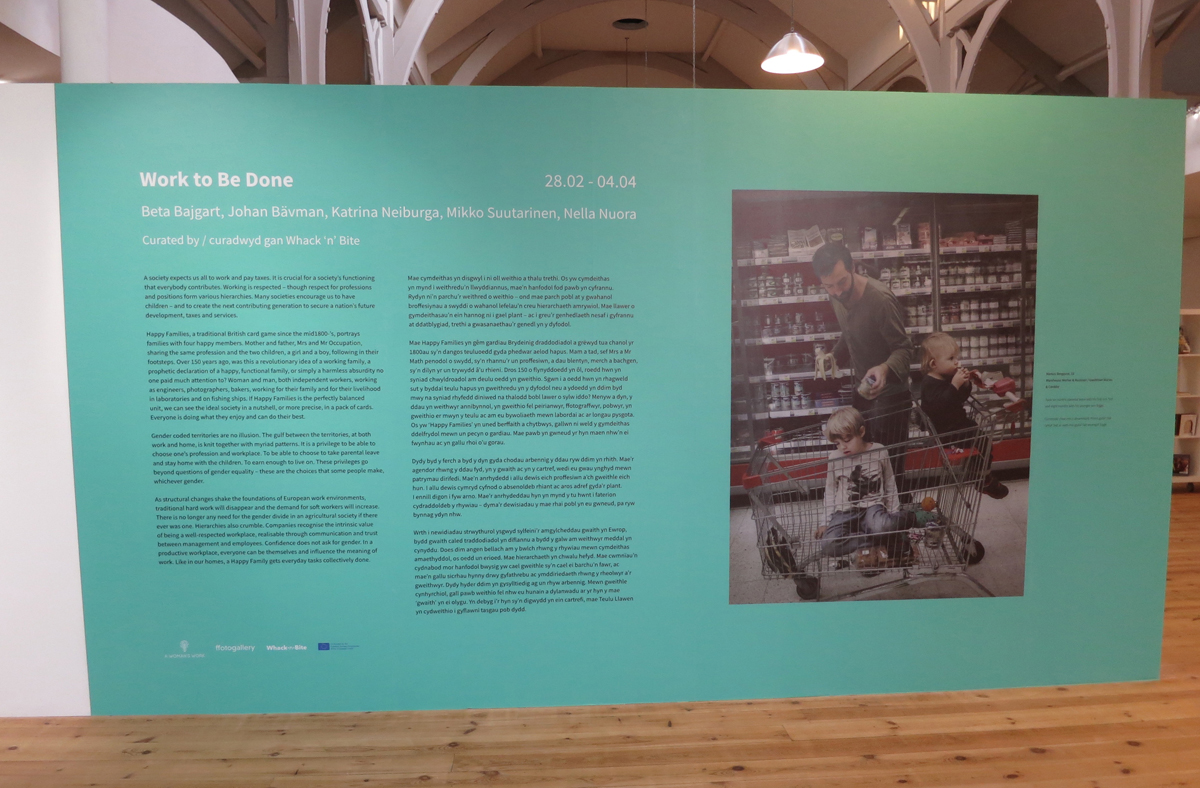Work to Be Done
Beta Bajgart (CZ/IR), Johan Bävman (SE), Nella Nuora (FI), Katrīna Neiburga (LV), Mikko Suutarinen (FI)
Ffotogallery, Cardiff, 2020 February
Curated by Whack ‘n’ Bite
A society premises us all to work and pay taxes. It is crucial for a society’s functions that everybody contributes. Working is respected – though respect on professions and positions form various hierarchies. Many societies also encourage us to have children – the next contributing generation to secure nation’s future development, taxes and services.
Happy Families, a traditional British card game since mid 1800’s, presents families with four happy members. Mother and father, Mrs and Mr Occupation, sharing the same profession, and the two children, a girl and a boy following in their footsteps of interest. Over 150 years ago, was this a revolutionary suggestion of a working family, a prophetic declaration of a happy, functional family or a harmless absurdity no one paid much of attention to? Woman and man – both independent workers, working as engineers, photographers, bakers – working for their family and for their lives in laboratories and on fishing ships. Happy Families as an example of balanced unit, we can see the ideal society in a nutshell, or more precise, in a pack of cards. Everyone is doing what they themselves enjoy and can do the best.
Gender coded territories are no illusion, but the gulf between the territories at both work and home is knit together with myriad patterns. It is a privilege to be able to choose one’s profession and work place. It is a privilege to be able to choose to take parental leave and stay home with the children. It is a privilege to earn enough for living. These privileges go beyond the questions of gender equality – these are choices for some, despite the gender.
As structural changes shake European work environments, traditional hard work will disappear and the demand for soft workers will increase. There is no longer any need for the gender distribution of agricultural society, if there ever was one. Hierarchies also crumble. Companies have the intrinsic value of being a well-respected workplace, and it is realizable through communication and trust between management and employees. Confidence does not ask for gender. In a productive workplace, everyone can be themselves and influence the meaning of work. Like in our homes Happy Family gets everyday tasks collectively done.
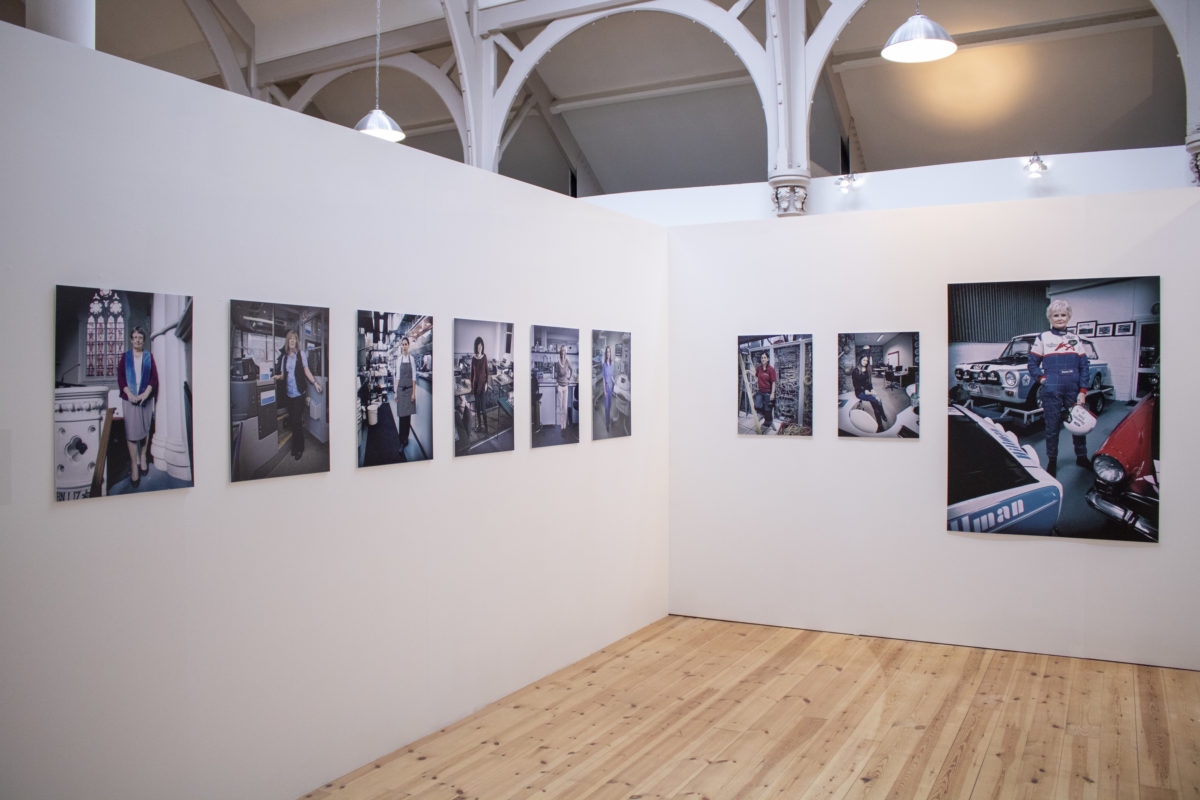
A Woman’s Work sits at the convergence of art and visual archiving. It is aimed to empower women while simultaneously examining ourselves and our place in modern society. Through A Woman’s Work, Bajgart captured the stories of 60 women who have chosen a career path in unusual and predominantly male professions. The work made her mindful of ongoing gender stereotypes in our society and the need to prevent them, by educating our children. Bajgart wishes to keep strengthening the conversations about the way women are choosing their professions and about their role in the community. A Woman´s Work by Beta Bajgart is also published as a photobook in 2017.

Swedish Dads is based on a series of portraits of fathers who belong to that small percentage of fathers who choose to stay at home with their children for six months or longer. With this project, Johan Bävman wanted to find out what made these fathers stay at home so much longer than most of their peers. What have they gained from this experience? In what way has the decision to take parental leave changed their relationship with their partner and their child? What expectations did they have before going on parental leave?
Sweden has one of the most generous parental leave policies in the world.The current system allows parents to stay at home with their child for a total of 480 days, while receiving an allowance from the state. Ninety days are earmarked for each parent, and cannot be transferred. The purpose of encouraging dads to take more parental leave is to promote gender equality. Despite a generous allowance, only a fraction of Sweden’s dads uses all of their allocated parental leave, and only fourteen per cent of parents split evenly.
Bävman has two aims of this photo project. Firstly, he wants to illustrate Sweden’s unique parental policy. Secondly, he wants to inspire other fathers – both in Sweden and further afield – to see positive benefits of taking a more active role in their young children’s lives. He doesn’t want to glorify the fathers in this series. Instead, he seeks to engage in a debate about why these dads are considered special.
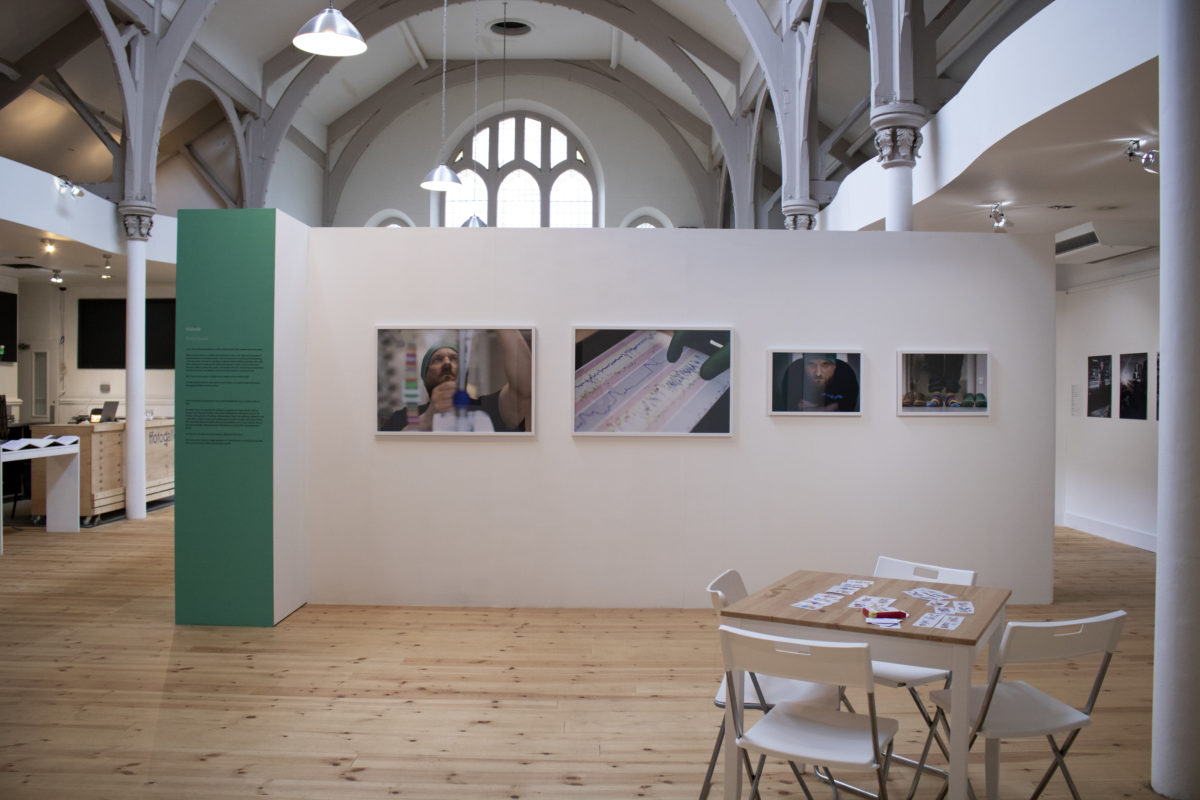
Midwife
“It is in this maternity ward that your child is safer to be born than anywhere else in the world.”
Mikko Tarvonen works as a midwife and he knows how to help a child safely in the world and reassure parents in an exciting situation. Tarvonen’s specialty is monitoring and interpreting a child’s heart chart. The role of a midwife is to help the mother (midwife etymology: mid = with, wife = woman) and to evaluate if the child needs help from outside. So far, the best way to examine a child is to analyze the cardiac curve drawn by the CTG. The learning of interpretation is passed down from one midwife to another, through experience and years at work.
Still, “There are two experts in childbirth: the midwife and the mother herself.”
The text is based on the YLE news article (Laura Kosonen, 12.10.2019), in which Nella Nuora photographed Mikko Tarvonen working.
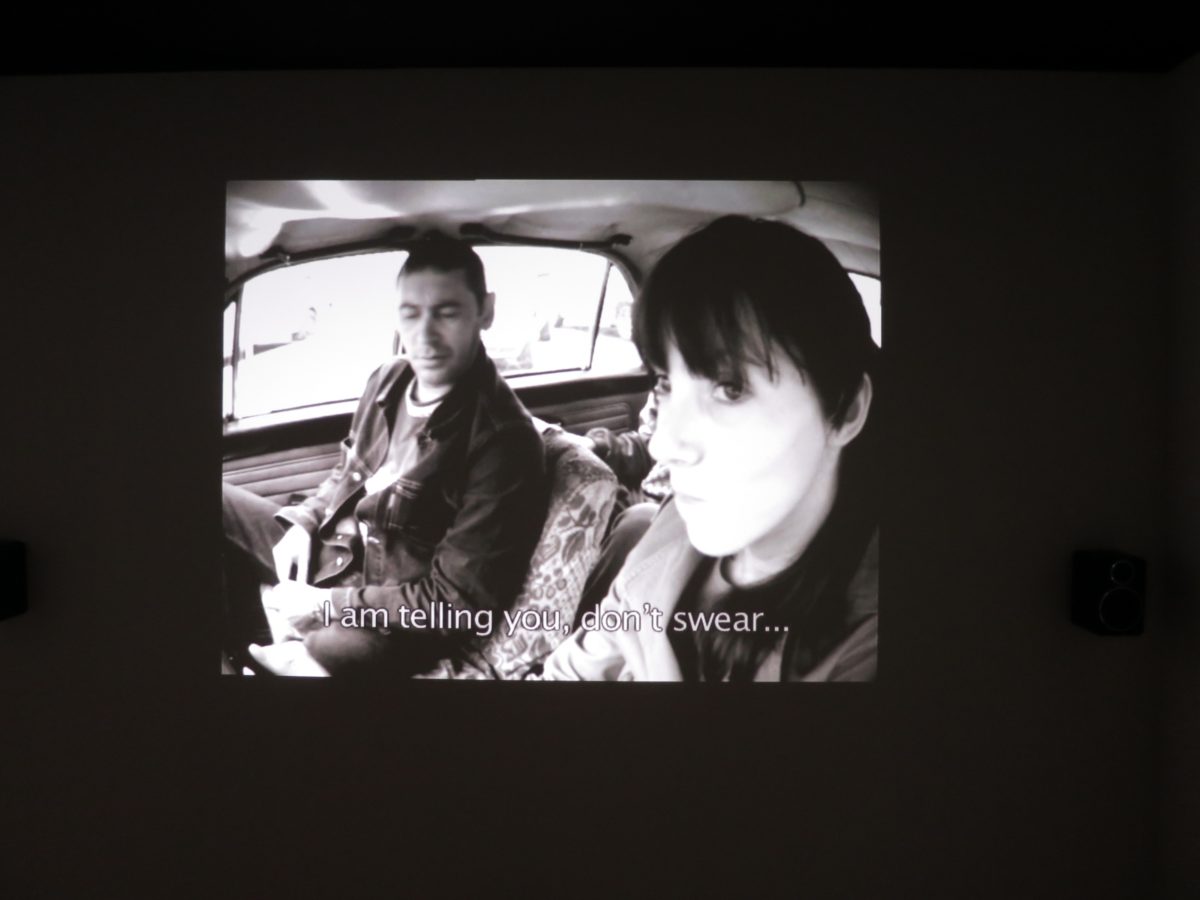
Traffic
Few of us have ever had a heart-to-heart with a taxi driver. Not just about the rates or the route ― about the spots passing by the taxi window, the rising prices, politics: in short, about life in general. That sort of conversation may turn either into a confession and solace offered by a stranger, or a tour through city territories and mundaneness.
Likewise, few of us have ever come across certain collector types who go for other people’s stories, extraneous experiences which intertwine with their own in a peculiar sort of fabric. Katrīna Neiburga is one of those people who collect stories ― on cultivating tea fungus, on what girls carry around in their handbags, on things normally told to no-one but a taxi driver or a random fellow-passenger in a train compartment. And yet Katrīna is not a true collector. It seems to be very important for her to be a part of the conversation, to spin a yarn and have a go at asking the person she’s talking to questions important to herself. The artist’s vital curiosity channels anthropological “archaeology” into creating a contributor-orientated situation.
Switching from object to situation in her practice of art Katrīna performs a virtuoso balancing-act between documentality and fiction. Having decided to make a temporary change of occupation and become a cabbie she taxis around residents of the Pārdaugava suburbs, talks to her passengers, listens to their stories and registers them. And afterwards visitors of the re:publika project and chance passers-by who happen to take an interest are offered an opportunity to spend some time in the old Volga car and watch the taxi driver’s dialogues with her passengers on a little monitor.
Accident combined with a staged situation, or rather an arbitrarily made-up set of rules, makes for ideal psycho-geographical premises. The unscheduled taxi routes and unpredictable people act almost like a drifting derivation method, allowing the revelation of a surprising urban texture and one to lose oneself in the stories told by random passengers.
The second part of the project consists of Katrīna’s interviews with female taxi drivers; this time it’s not just an extension of situative context but also a materialisation of focused interest manifested in the Sestais elements (The Sixth Element) women’s art project and in a study of interplay and succession in her own family’s female line. Women’s position determined by social roles and traditions without explicit feminist articulation becomes the subject of the artist’s analysis.
The grey-haired taxi driver’s stories of curious incidents dating from the Soviet era, her family problems, adventures and worries about an insecure future create a portrait of a strong woman ― one it’s so easy to identify with if you live in Latvia. Assembling assorted fragments of other people’s experiences is Katrīna’s way of making marginal notes of sorts and possibly of getting closer to eventually writing a body matter on herself.
Text by Solvita Krese
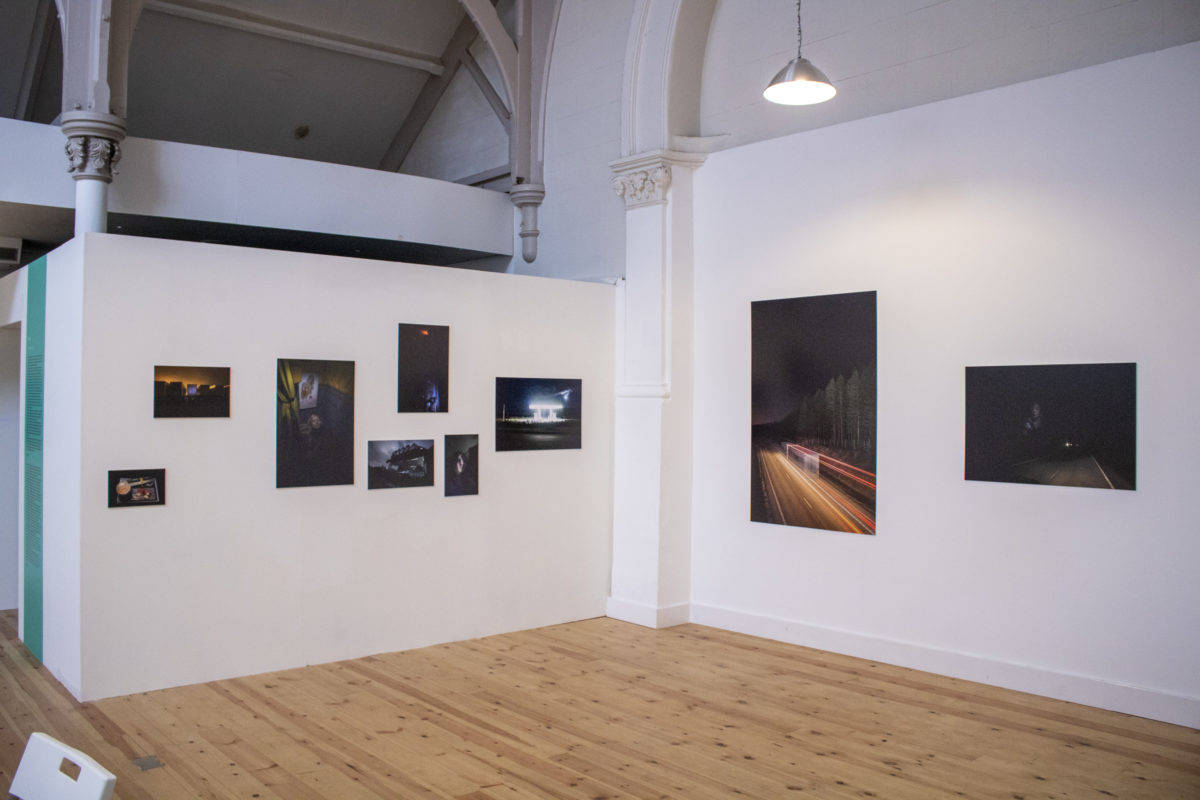
Truckers
The Finnish law on Vechicles Act imposes truck, bus, lorry and combination vehicle drivers to have a professional qualification in the transport of good and passengers on board. Vocational training shall include training on the requirements imposed on a driver, on road safety and on the safety of the driver and the carriage, and on professional practice in the transport and other functions of the driver.
The job of a truck driver is to carry the goods, to load and unload the cargo, to take care of the transport documents and to provide customer service. In addition, the work includes car maintenance and minor repairs. The work requires independency, responsibility and punctuality. The rules governing the working hours and rest periods of drivers are uniform throughout the European Union and the EEA.
“When a man makes a mistake, it’s just a mistake. When a woman blunders, she can’t.”
Jenna Keinänen, 20
”I am the first truck driver in my family and proud of it.”
Eveliina Heiskanen, 24
“When I graduated as a hairdresser, I knew right away that I was in the wrong field. After two and a half weeks I quit. Even though my grandma, grandpa and father were driving the truck, I wasn’t interested in cars until I was 17.”
Jasmin Tuominen, 27
(The quotes are published in Helsingin Sanomat, Minttu Storgårds ja Pauliina Toivanen, 12.7.2017.)
Reviews on the exhibition: Wales Arts review, Cardiff Student Media
Work to be Done was part of the Creative Europe programme’s project A Woman’s Work lead by Ffotogallery (UK) in partnership with Lithuanian Photography Artists’ Union (LI), Gallery of Photography (IR), Le Château d’Eau (FR), Fotosommer Stuttgart e.V. (GR) and Whack ‘n’ Bite (FI).
Whack ‘n‘ Bite
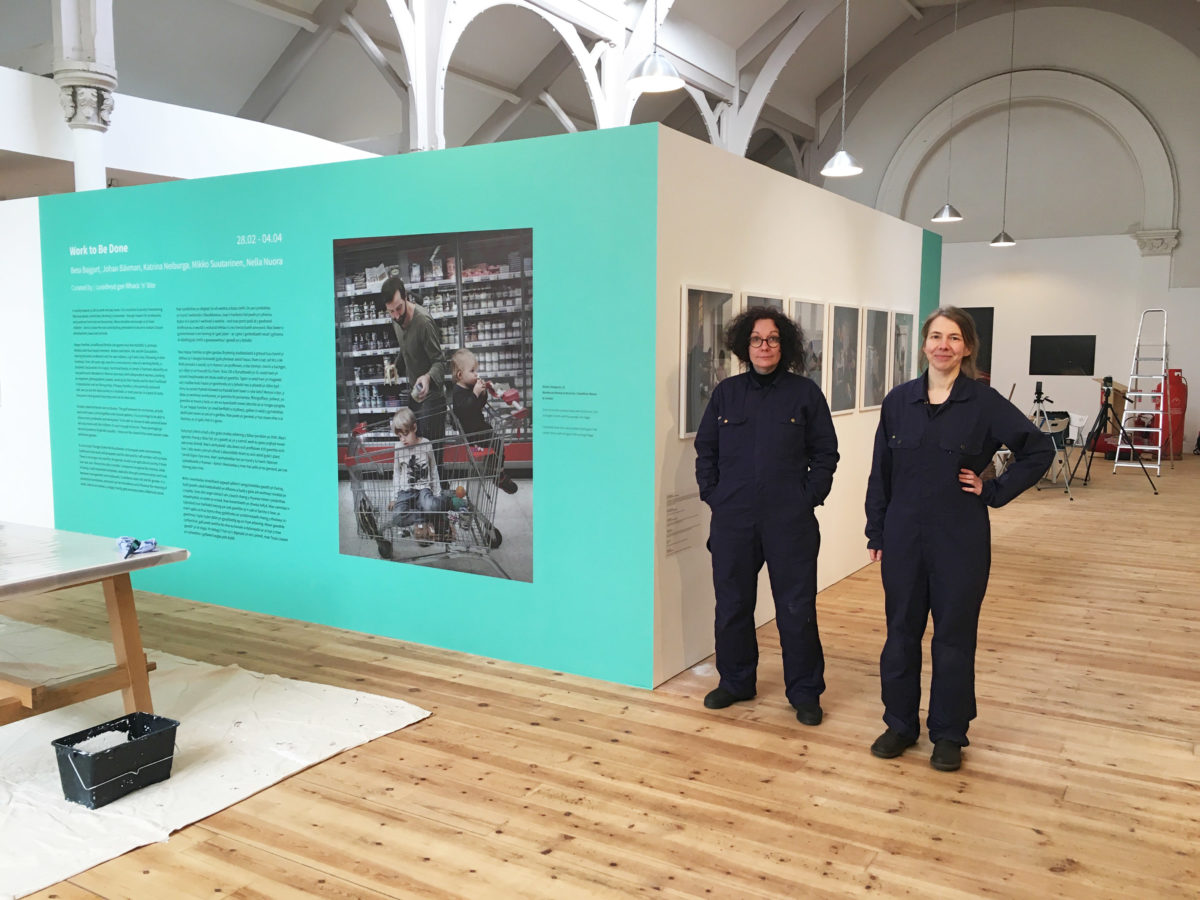
Whack ‘n’ Bite (est. 2018) is a visual band and construction site duo with two founding members, curator Tuula Alajoki and visual artist / designer Johanna Havimäki from Finland. Whack ‘n’ Bite operates in art collaborations and as a background force for artists and their international facilities. Both Alajoki and Havimäki have art labour background in visual arts including both manual work and management. This background forms the core to the construction site for Whack ‘n’ Bite functions, we deliver support in terms of constructing, networking, organizing as well as visuals, at production and international collaborations.
Contact: whacknbite[at]gmail.com
